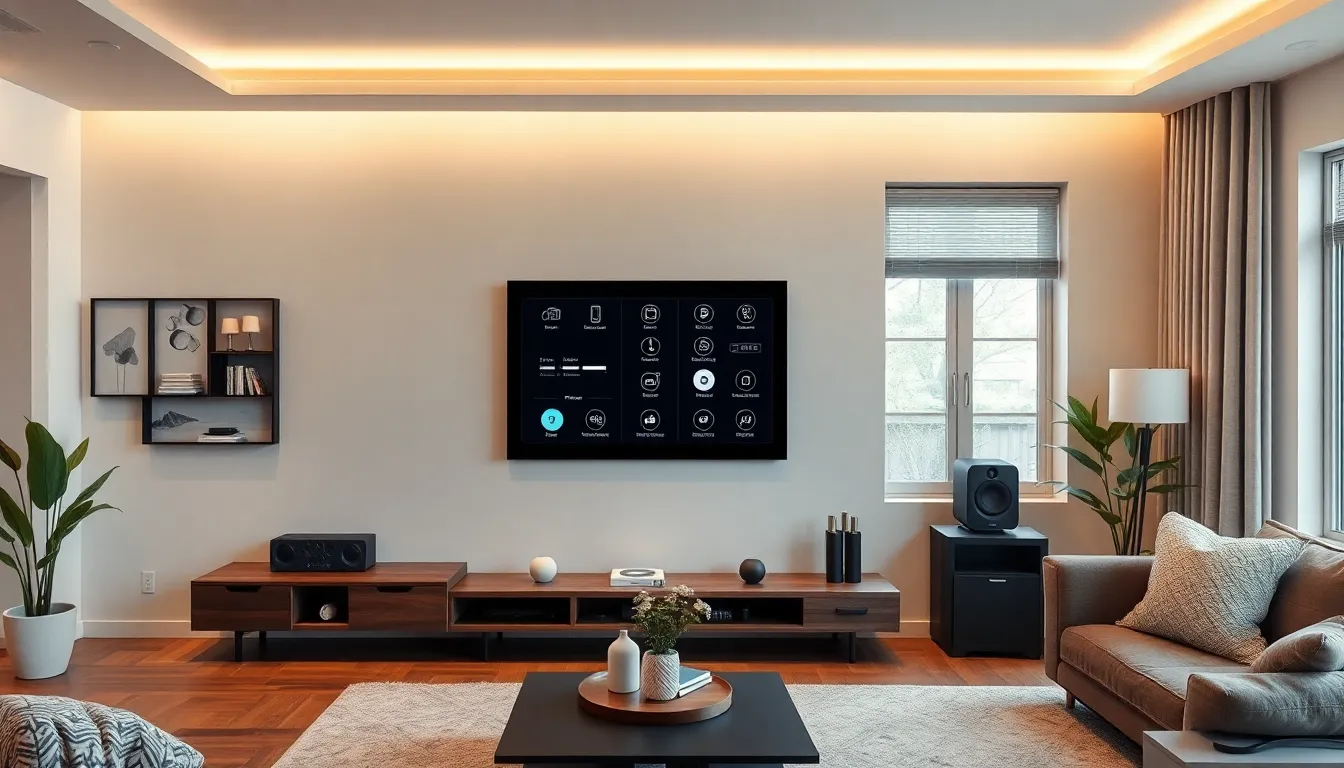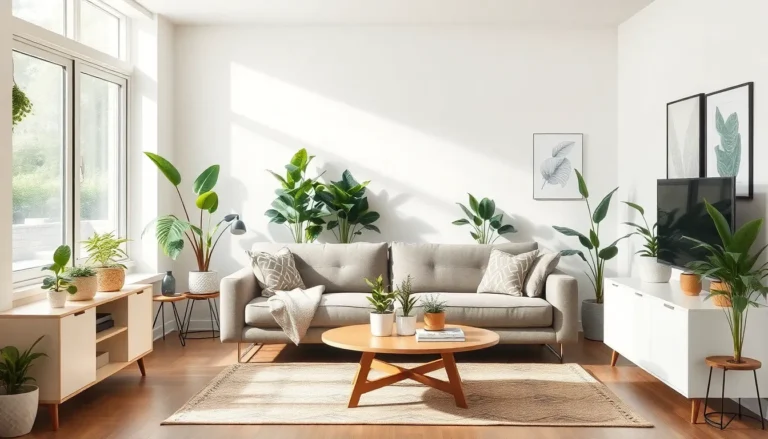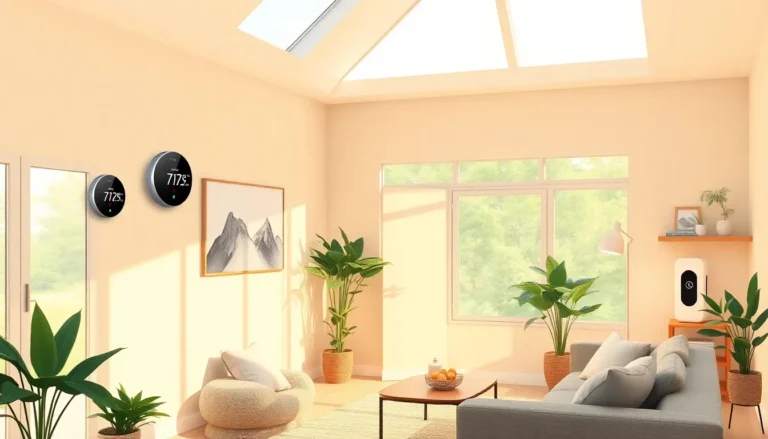Imagine sitting on your couch, remote in hand, and with a single click, you transform your living room into a cozy movie theater or a vibrant dance party. Welcome to the world of remote scene activation, where the power of ambiance is just a button away. This nifty technology takes home automation to the next level, allowing you to set the mood without breaking a sweat—or even getting off the couch.
Gone are the days of fumbling with multiple switches and settings. With remote scene activation, it’s all about convenience and creativity. Whether it’s dimming the lights for a romantic dinner or cranking up the tunes for a family gathering, this feature makes it easy to impress without the hassle. So grab that remote and get ready to unleash your inner home entertainer. Who knew setting the stage could be this much fun?
Table of Contents
ToggleOverview of Remote Scene Activation
Remote scene activation enables seamless control of light, temperature, and audio within a home. Users create predefined settings for various occasions, simplifying the process of adjusting multiple devices at once. This feature often integrates with smart home systems, enhancing connectivity and user experience.
Various devices can be connected to remote scene activation, including smart bulbs, thermostats, and speakers. These devices work together to create specific environments, offering versatility in home automation. For example, a “Movie Night” scene can dim the lights, adjust the thermostat, and lower the blinds with just one command.
Users appreciate the convenience that remote scene activation provides, especially when entertaining guests or relaxing at the end of the day. A single button press can shift the atmosphere of an entire room, eliminating the hassle of manual adjustments. Automated routines can also be set for different times of the day, allowing for tailored experiences.
Numerous platforms support remote scene activation, such as Google Home and Amazon Alexa. These systems utilize voice commands, further enhancing accessibility. Users manage their scenes through mobile applications, enabling control even when away from home.
Data shows that homes equipped with remote scene activation experience increased energy efficiency. By optimizing settings based on preferences, energy consumption is reduced without sacrificing comfort. Additionally, the technology supports customization, allowing users to modify scenes according to their tastes.
Key Features of Remote Scene Activation

Remote scene activation provides essential functionalities that enhance home automation experiences. Users gain substantial benefits from intuitive designs and device compatibility.
User Interface Design
User interfaces prioritize simplicity, making it easy for individuals to create and manage scenes. Touchscreen controls or mobile applications enable quick adjustments to lighting, temperature, and audio settings. Visual displays clearly indicate available scenes, providing users with straightforward options for customization. Friendly designs encourage exploration, making the technology accessible even for beginners. Seamless navigation allows users to activate desired environments without complex steps or confusion.
Compatibility with Devices
Compatibility with various devices stands out as a crucial feature. Devices such as smart lights, thermostats, and speakers integrate seamlessly into remote scene activation systems. Major platforms like Google Home and Amazon Alexa support this technology, allowing voice command execution for hands-free operation. Many manufacturers align their products with common protocols, ensuring broad compatibility for users. The ability to connect multiple devices enhances the overall experience by delivering cohesive atmospheres tailored to specific occasions.
Benefits of Remote Scene Activation
Remote scene activation provides numerous advantages for users seeking efficiency and comfort in their homes. This technology enhances everyday experiences while improving overall functionality.
Convenience and Accessibility
Convenience defines remote scene activation. Users easily control multiple smart devices with one click, streamlining home management. Mobile apps offer access to settings from anywhere, allowing users to adjust environments while away. Individuals preparing for guests can set favorable scenes quickly without scrambling around. Voice commands further enhance accessibility for those with mobility challenges. Control behaves intuitively; commands can create scenes that fit various occasions, like movie nights or dinners alike. This adaptability to users’ preferences promotes an inviting atmosphere, leaving behind complex setups.
Enhanced Security Measures
Enhanced security measures arise from remote scene activation’s capabilities. Users program specific scenes to simulate occupancy, improving home security during vacations. Lights flickering on and off at random intervals can deter potential intruders. Integration with security devices such as cameras adds another layer of protection. Notifications alert users to unusual activity via mobile applications. Automated routines mean homeowners can maintain security measures effortlessly, without constant monitoring. Overall, these features contribute to a safer living environment, allowing individuals to feel secure within their homes.
Limitations of Remote Scene Activation
Despite its numerous benefits, remote scene activation faces several limitations. Users must navigate potential technical challenges and privacy concerns.
Technical Challenges
Integration with various devices can pose difficulties. Compatibility issues arise between different brands and protocols, frustrating users during setup. Network reliability proves crucial; weak signals can disrupt the functionality of smart devices. Additionally, updates to software may create temporary disturbances, impacting seamless user experience. Devices need consistent updates and maintenance, adding to long-term costs and potential service interruptions. Moreover, users often experience a steep learning curve with complex systems, detracting from the intended convenience of the technology.
Privacy Concerns
Privacy issues present significant challenges for remote scene activation. Data collection from smart devices raises concerns about user information security. Unauthorized access to home networks can lead to personal data breaches, causing anxiety among consumers. Many users remain unaware of how their data is stored, shared, or sold, contributing to a lack of trust in these systems. Additionally, relying on cloud services for control means users may face risks if those services encounter breaches. Maintaining privacy while enjoying smart home features requires diligent attention and robust security measures.
Future Trends in Remote Scene Activation
Advancements in remote scene activation technology drive increased integration with artificial intelligence. AI algorithms analyze user preferences, adapting scenes based on habitual usage. Such personalized experiences enhance convenience, ensuring that homes cater to individual needs effortlessly.
The rise of Internet of Things (IoT) devices supports interoperability among various platforms. This trend allows diverse device manufacturers to collaborate, providing users with more options. Increased compatibility fosters a seamless environment where devices communicate effectively, contributing to an engaging user experience.
Voice activation continues to evolve, transforming how users interact with their smart homes. Improvements in natural language processing make voice commands more intuitive, resulting in enhanced functionality. Users benefit from this trend, as they can manage their settings without complicated instructions, simply by speaking their desires.
Data privacy is gaining attention as consumers become more aware of security issues. As concerns increase, manufacturers are prioritizing robust data protection measures. Users can feel confident that their information is safeguarded while enjoying the conveniences of remote scene activation technology.
Furthermore, the development of energy-efficient solutions plays a vital role in future trends. Innovations focus on smart devices optimizing energy consumption based on user behavior and environmental conditions. Energy savings not only reduce bills but also support environmental sustainability, making homes smarter and greener.
Lastly, the demand for enhanced user interfaces is on the rise. Manufacturers are designing more intuitive applications that simplify scene management. Better interfaces help users customize experiences quickly, encouraging widespread adoption of remote scene activation solutions across different demographics.
Remote scene activation is revolutionizing how individuals interact with their living spaces. By streamlining control over various smart devices, it enhances convenience and elevates home experiences. With the ability to set specific atmospheres for any occasion, users can enjoy tailored environments at the touch of a button.
The integration of AI and IoT technologies promises even more personalized experiences in the future. As manufacturers prioritize user-friendly interfaces and data privacy, remote scene activation is set to become an essential feature in modern homes. This technology not only simplifies daily routines but also contributes to energy efficiency and enhanced security, making it a valuable addition to any smart home ecosystem.








